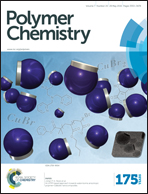Engineered non-toxic cationic nanocarriers with photo-triggered slow-release properties†
Abstract
The charge density of polymers involved in drug delivery is a key parameter during cellular uptake; moreover, the nature of charged groups determines the encapsulation efficiency and nanocarrier stability. Unfortunately, the high toxicity and the burst release of loaded cargo are their major drawbacks. We have developed here a versatile strategy to design photo-responsive nanocarriers showing high stability, slow-release properties and low cytotoxicity. These delivery vehicles are intended to prolong the drug effect, reducing the dose frequency, decreasing the side effects and maintaining a proper level of the drug. Diblock copolymers based on poly(dimethylsiloxane) and poly(2-dimethylaminoethyl methacrylate) containing pendant photo-cleavable 2-nitrobenzyl moieties were synthesized by atom transfer radical polymerization and post-polymerization modification, and then self-assembled into nanoparticles. Dynamic light scattering and transmission electron microscopy showed that the size and morphology of nanoparticles were not affected by UV exposure. Nanoparticle cytotoxicity was evaluated in relation to the number and nature of positively charged units. The nanocarriers containing copolymers with a longer charged block were successfully taken up by cells and were non-toxic both before and after irradiation up to 300 μg mL−1. The slow photo-induced release of a negatively charged molecule, sulforhodamine B, reveals that the delivery is controlled not only by the photo-triggered transformation of hydrophilic blocks from cationic to zwitterionic, but also by a combination of forces that induce the self-assembly but do not allow the disruption of nanoparticles. Results suggest that this polymeric system plays a promising role as a nanocarrier for sustained, triggered drug delivery, preserving the non-toxicity after release.


 Please wait while we load your content...
Please wait while we load your content...